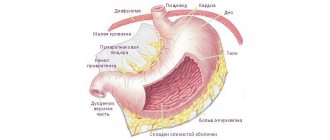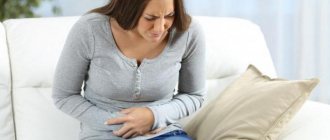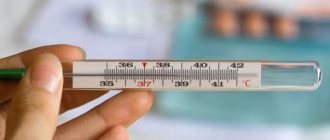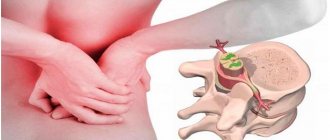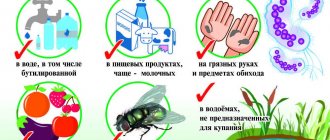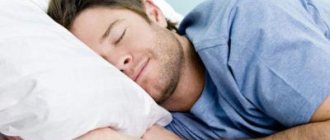Gastritis is a disease of the stomach caused by damage to its mucous membrane. Everyone knows that with gastritis the abdominal area hurts. Those who have encountered this disease in one way or another know that the pain is usually localized in the upper part, under the sternum - in the epigastrium, and can be accompanied by heartburn, belching and other unpleasant symptoms. But few people know that pain can also radiate to the back. It would seem - what does the back have to do with it? However, a fact is a fact - sometimes gastritis radiates to the back. Let's find out whether back pain can occur with gastritis, how often and in what cases this happens.
Can gastritis be accompanied by back pain?
Main reasons
If both the stomach and the back hurt at the same time, then doctors first of all suspect that they are affected by an inflammatory or degenerative pathology. This combination of uncomfortable sensations is not so rare. And all because of the commonality of innervation - communication between nerves and the central nervous system. Severe pain accompanies the course of many stomach diseases, for example, erosive gastritis. It is not always localized directly in the epigastric region, but spreads along the nerve, extending into the spine at the level of the chest.
An interesting fact is that this combination of painful sensations can occur in the absence of stomach and back problems. Its causes include damage to organs located both nearby and at a considerable distance:
- Pathologies of the urinary system in the acute stage are manifested by such acute pain that they are felt throughout the entire abdominal cavity. This is typical for renal failure, pyelonephritis, glomerulonephritis;
- Intestinal pathogens, if left untreated, quickly spread throughout the entire digestive tract, causing severe inflammation of its walls. The more pronounced it is, the higher the likelihood of pain in the sternum and lower back;
- when stones pass from the gall or bladder, piercing pain occurs, radiating to the back, groin and even hip joints;
- due to the formation of a hernia in the groin area, muscle tissue is periodically pinched, causing acute pain. But it is especially strong when it compresses a sensitive nerve ending;
- the development of an infectious process in the urethra, ureters, bladder only at the initial stage is manifested by localized pain. As pathogenic microorganisms ascend towards the kidneys, they spread to the peritoneum and are felt in the stomach and spine.
In men, a similar combination of unpleasant sensations is observed with acute inflammation of the prostate gland, vesicles, and urethra. In women - with severe erosive damage to the appendages, uterus and ovaries, as well as the formation of fibroids. In such cases, the cause of pain in the stomach and back is not difficult to determine, since in the area of the genitourinary system they are felt much more strongly.
Prevention
You can avoid stomach problems by following these recommendations:
- Review your diet and remove fatty and fried foods from it.
- Eliminate bad habits.
- Reduce the number of buns, pies and cakes you eat.
- Eat only freshly prepared food.
- Avoid fast foods.
- If you have a history of gastritis or ulcers, undergo regular preventive examinations.
- Eat often, but in small portions.
No drug therapy will give the desired results if you do not adhere to proper nutrition.
Gastrointestinal problems
Can your stomach and back hurt for natural reasons? It’s rare, but it does happen. For example, due to banal indigestion after eating fatty, fried foods. Enzymes and hydrochloric acid do not cope with their work, so the food bolus stagnates in the stomach. This leads to the development of putrefactive and fermentative processes, the appearance of heartburn, sour belching, and severe pain in the epigastric region. They spread along the nerves to the thoracic segments of the spine, and when the intestines are involved, they extend to the lower back.
This is also possible during pregnancy. Hormonal fluctuations and changes in eating habits do not contribute to proper digestion. The situation is aggravated by compression of the nerve endings by the ever-growing uterus. But consultation with a doctor is necessary even in a single case of general pain syndrome. After all, it is also characteristic of pathologies of the urinary and reproductive systems.
Pancreatitis
Severe pain may indicate another exacerbation of chronic pancreatitis. Due to inflammation of the pancreas, the enzymes it secretes are not released into the duodenum, which leads to digestive disorders. Violation of its intra- and exocrine function is manifested by the following symptoms:
- severe pain in the upper abdomen and left hypochondrium;
- dyspeptic disorders - nausea, vomiting, heartburn;
- yellowness of the skin and sclera.
With inflammation of the pancreas, pain from the stomach area spreads to the spinal column
If the patient follows all medical recommendations, the prognosis is favorable. A violation of the diet, drinking alcoholic beverages, and smoking lead to the progression of degenerative processes in the tissues of the gland, the development of severe complications, many of which require surgical intervention and can be fatal.
Gastritis and ulcerative lesions
With any of these pathologies, pain from the epigastrium can radiate to the back, masquerading as thoracic or lumbar osteochondrosis. This condition occurs especially often with erosive and hypoacid gastritis. In the first case, the cause of burning pain is the contact of hydrochloric acid or foods saturated with salt and spices on exposed areas of the mucous membranes. And with hypoacid gastritis, insufficient gastric juice is produced, which provokes stagnation of the food bolus, bloating, and excessive gas formation.
Even more often, pain in the stomach and any part of the back occurs together when an ulcer forms. It is formed as a result of the simultaneous weakening of the protective mechanisms of the mucous membrane, exposure to aggressive internal factors, and a disorder of the evacuation function of the digestive tract. For example, due to gastric hypokinesia, duodenogastric reflux.
Ulcerative lesions are characterized by frequent alternation of periods of remission and relapses. During exacerbation, pain appears and quickly increases in the epigastrium and in the area of the xiphoid process of the sternum. If the pathology is localized directly in the body of the stomach, then discomfort is felt on the left. When an ulcer forms in the pyloric region - on the right. Quite often the pain radiates to the lower back and radiates between the shoulder blades.
IMPORTANT! With atypical forms of peptic ulcer, pain may occur in the iliac region (identical to inflammation of the appendix), in the heart (cardiac), and in the lower back (radiculopathy).
Oncological pathologies
A malignant tumor of the stomach arises from the cells of the mucous layer and gradually spreads to the muscular and serous layers. When it grows into the blood vessels, gastric bleeding occurs, predisposing to severe anemia, general weakness, and high fatigue. The formation and gradual enlargement of a malignant tumor is also manifested by the following symptoms:
- weight loss as a result of suppressed appetite, impaired absorption of nutrients, vitamins, minerals;
- shortness of breath even after minor physical exertion;
- fever, chills, cold sweat;
- temperature fluctuations above subfebrile values (37.1-38.0°C);
- enlarged lymph nodes.
The growing tumor puts more and more pressure on the nerve roots, so the intensity of the pain steadily increases. Quite quickly they begin to be felt in the lower abdomen and back, spreading throughout the spinal column.
Cholecystitis
This is the name of an inflammatory lesion of the gallbladder, which is characterized by pain in the right hypochondrium, radiating to the right arm and collarbone, nausea, vomiting, diarrhea, and flatulence. Exacerbation of cholecystitis is preceded by emotional stress, dietary errors, and alcohol abuse. When cholecystocardial syndrome occurs, dull pain in the upper back, tachycardia, and heart rhythm disturbances occur.
The acute course of cholecystitis is complicated by severe stomach pain radiating to the back
Uncomfortable sensations are most pronounced during the period of exacerbation or after exposure to provoking factors. During remissions, pain in the back and stomach is rarely a concern. But in some patients it is permanent, which negatively affects not only their physical, but also their psycho-emotional state.
Appendicitis
This is a fairly common pathology that is diagnosed mainly in children, adolescents and young adults. As a result of acute, less often chronic inflammation of the cecal appendage, acute pain occurs in the right iliac region. They are not clearly localized, but radiate to the lower back and lower chest. At the same time, digestion is disrupted, the person suffers from attacks of nausea and vomiting, chills, and fever.
At the initial stage of development of the inflammatory process, pain is felt in the epigastric and periumbilical areas. If the appendix is located atypically, then it soon appears in the right hypochondrium, lower back, pelvic organs, above the pubis. Regardless of the intensity of the pain, the prognosis is favorable - the person recovers completely in about a month.
ATTENTION! Appendicitis is dangerous due to its complications - the formation of an inflammatory infiltrate, interintestinal abscess, and adhesive intestinal obstruction. Death is possible with delayed hospitalization and untimely surgical intervention.
Features of treatment
Therapy depends on the type of gastritis: acute or chronic, with low or high acidity of gastric juice. If the lesion is caused by Helicobacter pylori, then special complex treatment regimens using antibiotics are prescribed. A necessary condition for eliminating any pain due to gastritis is diet. All medications and procedures are prescribed by a doctor. Therefore, it is important to tell the specialist in as much detail as possible about the nature of the pain syndrome and accompanying sensations in the back area. Additional examinations and tests will provide an accurate clinical picture, which will make it possible to prescribe correct and successful treatment.
Renal colic
Most often, renal colic occurs against the background of urolithiasis, which is characterized by the formation of stones in the bladder. Somewhat less frequently, they can be triggered by injuries or tuberculous kidney damage, benign and malignant neoplasms, and pyelonephritis. With renal colic, the pain is sharp, burning, piercing, and can cause fainting. They are localized in the lower back, and then begin to spread down the ureter. Due to the common innervation, severe pain in the lower part of the stomach is possible. Associated symptoms are:
- frequent and painful urination;
- nausea and vomiting;
- psychomotor agitation.
Even parenteral administration of non-steroidal anti-inflammatory drugs is often not enough to relieve pain. Only narcotic analgesics can cope with them.
First aid for acute pain
Since most conditions accompanied by acute pain require immediate surgical treatment, you should not try to get rid of the pain on your own. It is forbidden to take analgesics, as this muffles the symptoms and does not stop the process . With a perforated ulcer or pancreatic necrosis, this is fraught with the development of peritonitis and sepsis. For the same reason, the patient should not be given food or drinks.
Algorithm for helping the patient before the ambulance arrives:
- Place the patient on the bed.
- Ensure air flow into the room: open the windows, remove the patient’s outer clothing.
- If possible, measure temperature, pulse and blood pressure.
- If vomiting or bleeding from the throat occurs, turn the patient on his or her side to prevent choking.
- Make sure that the patient is conscious and, if necessary, give ammonia to sniff.
Spinal diseases
People suffering from pathologies of the digestive tract experience stomach pain quite often. Therefore, at first they do not pay attention to the fact that the discomfort is felt from behind - in the back. And at this time, a degenerative-dystrophic disease develops in one of the parts of the spine. With timely treatment, it can be quickly eliminated.
Osteochondrosis
Simultaneous pain in the back and at the level of the stomach is a typical sign of the progression of thoracic osteochondrosis. As the body naturally ages, the cartilage tissue of the intervertebral discs is destroyed. They become dehydrated, crack, and lose their ability to absorb shock loads. At the first stage of osteochondrosis, symptoms almost do not arise - their intensity increases at the 2nd stage of development of the pathology.
Why does my back hurt below my ribs?
Why do both the stomach and the back in the area of the thoracic vertebrae hurt at the same time:
- due to the thinning of the intervertebral discs, the vertebral bodies begin to deform;
- bone tissue grows with the formation of growths - osteophytes;
- when the spinal root is compressed by a growth, the spine begins to ache;
- pain spreads along the nerves and is felt not only in the stomach, but also in the liver and small intestine.
Due to disruption of the innervation of internal organs, symptoms of gastritis, gastric and duodenal ulcers occur in the form of digestive disorders and peristalsis. Therefore, patients with thoracic osteochondrosis turn not to a neurologist or vertebrologist, but to a gastroenterologist. Only after a thorough diagnosis does the true cause of poor health become clear.
When the spine is affected by osteochondrosis, pain is felt not only in it, but also in the stomach
THIS IS INTERESTING! An experienced diagnostician is able to quickly determine the cause of nausea, vomiting, heartburn, and stomach pain. Unlike gastrointestinal pathologies, with osteochondrosis the appearance of such symptoms is not associated with the nature of nutrition or changes in the daily menu.
Intervertebral thoracic hernia
Intervertebral hernia is formed at stages 2-3 of osteochondrosis. In a patient, due to loss of stability of a certain vertebral segment, the intervertebral disc protrudes between the vertebral bodies. The leading symptoms of a hernia from the musculoskeletal system are tonic muscle tension and limitation of movements in the affected area of the spine. When the spinal roots, blood vessels and spinal cord are compressed, signs of damage to other vital systems appear. The nature of the symptoms depends on the location of the hernial protrusion:
- upper thoracic region - pain in the upper parts of the chest, disorders of esophageal motility, difficulty swallowing;
- mid-thoracic region - unilateral or bilateral girdle pain along the intercostal nerves, pain in the stomach, dyspepsia, pancreatic enzyme deficiency, carbohydrate metabolism disorders;
- lower thoracic region - pain under the ribs, in the upper abdomen, intestinal dyskinesia.
A hernia manifests itself as an aching, dull painful sensation in the back. Gradually, the protrusion becomes larger and puts a lot of pressure on the nerve endings. Now one awkward movement (turning or bending) is enough to cause a piercing, shooting pain in the back, which will radiate to the stomach.
How to get rid of discomfort
If, in addition to the stomach, your back begins to hurt or vice versa, then it is not advisable to hope for a quick disappearance of the symptoms. Like swallowing painkillers by the handful. Pain syndrome is only a protective reaction of the body, with which the central nervous system signals about problems that have arisen. It is necessary to consult a doctor: neurologist, vertebrologist, gastroenterologist. A visit to a therapist would not be a mistake either. He will prescribe the necessary diagnostic measures, and then refer the patient for further treatment to a specialist doctor. Before visiting a medical facility, you can cope with aching, dull pain on your own. What do we have to do:
- take an antispasmodic, for example, No-shpa or domestic Drotaverine;
- Apply Fastum, Artrosilene, Diclofenac ointments to your back.
To eliminate stomach and spinal pain, the use of analgesics is not enough - it is necessary to determine their cause
It is strictly forbidden to warm the back or stomach area, including with burning ointments. In the presence of an acute inflammatory process, it will spread to healthy tissues and organs.
With combined pain in the stomach and spine, the situation cannot be corrected with the help of analgesics. It is necessary to establish the cause of periodic or constant pain, and then undergo a full course of treatment.
When should you see a doctor?
Some patients, assuming that their back hurts due to gastritis, do not seek additional advice from a doctor. They continue their treatment with previously prescribed medications and cope with symptoms with the help of painkillers. Such actions are absolutely wrong, since there is a possibility of developing other diseases, including ulcers, cholecystitis, pancreatitis. The lack of appropriate measures leads to a worsening of the situation and the pathology reaches advanced stages.
Despite the many folk remedies that help get rid of signs of diseases of the digestive and other systems, they must be used with extreme caution.
If the pain is tolerable and there are no pronounced other symptoms, then you need to independently consult a doctor and undergo diagnostic measures. There are situations when you do not need to wait for a specialist’s appointment, but call an ambulance. It is advisable to do this if the following is added to back pain:
- Pain of any localization, characterized by its intensity and duration. It doesn’t matter where it is concentrated, if it is unbearable, then urgent measures must be taken to eliminate it.
- Nausea, repeated vomiting. The masses contain blood or mucous clots, bile, and brown deposits are observed.
- Increased temperature, chills, fever.
- Diarrhea or prolonged constipation, frequent alternation of these phenomena. There is blood in the stool.
Before the ambulance arrives, you need to ensure rest, do not eat food, and if you have existing diagnoses, for example, stomach ulcers, do not take medications. this may reduce symptoms and complicate diagnosis.
